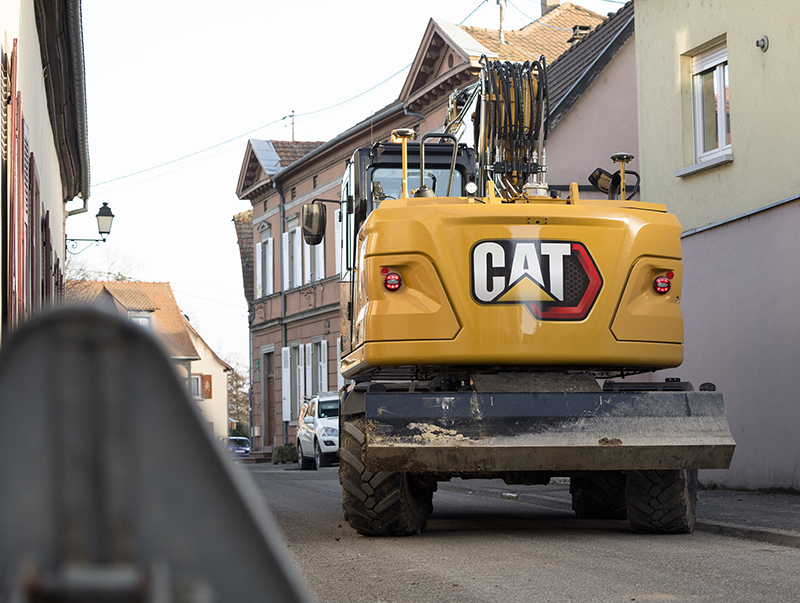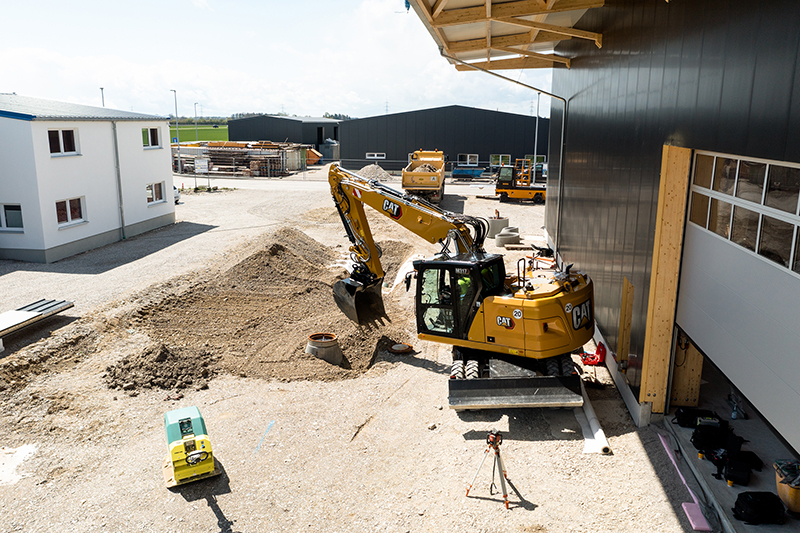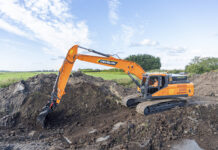As urban development and infrastructure projects increase, so does the demand for highly versatile machinery. Here George Ionescu, product manager at Finning UK & Ireland, discusses the benefits wheeled excavators can bring to the urban construction industry.
Urban growth and infrastructure demand
In the next five years the UK Government aims to deliver 1.5 million new homes across the country. Along with this will come an upturn in infrastructure projects to facilitate these new residential developments. New roads, utilities and social infrastructure such as schools, healthcare and communal green spaces all create additional requirements on local construction companies who will be looking to complete work to tight deadlines, efficiently and economically.
In addition to these residential development targets, there continues to be a focus on adaptive reuse of inner-city buildings. The innovative reuse of inner-city warehouses into mixed-use spaces such as offices and residential buildings is favoured for its circular economy, sustainability and heritage preservation. However, there are specific challenges to construction in this area including limited space and existing infrastructure which needs to be considered to ensure projects are delivered successfully.
In order to tackle the increasing demand in residential and urban development projects, it is vital to look at the ways we can adapt to ensure we are working sustainably, efficiently and cost effectively. Fundamental to these considerations is using heavy machinery that is not only fit for purpose but excels in an urban environment.
Versatility, mobility and street smarts
When it comes to heavy machinery, wheeled excavators are the urban experts, perfectly designed to tackle both the specific challenges in urban construction and the increase in demand we are currently seeing. They uniquely combine mobility, versatility and efficiency whilst still retaining the familiarity of their tracked counterparts.
For instance, the Cat M315 wheeled excavator – often fondly referred to as a rubber duck – may appear externally different to the Cat 315 but the operators would find the general operation to be identical, allowing for smooth transition between a tracked and wheeled machine.
When operating in a busy urban environment it is vital machines are versatile and able to handle diverse tasks from trenching to material handling or demolition. Wheeled excavators, or rubber ducks, are compatible with several attachments specifically designed for these applications. In addition, these machines also have a two-piece boom which is extremely beneficial for compact operation due to its adjustable height, enhanced reach and ability to navigate obstacles such as bridges and railings.
Urban construction is typically defined by limitations in space due to existing infrastructure. By their very design rubber ducks are far more sensitive to their environment than the tracked version in that they can travel on paved roads. This is vital when working in built up areas where you want to limit the damage caused to roads, pavements and other existing infrastructure which wouldn’t be possible on tracks.
Alongside this, they are often more compact and therefore more manoeuvrable than the tracked excavators which means they are easier to operate in the confined parameters of urban environments, between buildings or through tight city streets.
Rubber ducks are not just an attractive proposition based on their physical prowess; they have considerable street smarts too. Integrated technologies such as Cat Grade for precisive digging, E-Fence motion restrictors and payload systems for tracking material weight all enhance the precision of these machines, which is again vital when you are working in small, busy urban spaces.
Sustainable, cost-effective and adaptable
Even with the projected growth of construction projects this year and into the future, there is still a significant economic pressure related to rising costs, material shortages and longer lead times. It is vital then that the machines we use give us the biggest ROI possible. Rubber ducks may be the answer to mitigating economic concerns on urban construction sites thanks to their lower maintenance costs because of simpler undercarriages and lower impact on components. Their ability to travel on roads also means haulage is also not an additional cost to the project.
Fuel savings are also a key component of what makes the wheeled excavators an economically viable option for urban construction. They consume less fuel, and this not only reduces general operating costs but also means they are a sustainable option long-term. For instance, at Finning new Cat wheeled excavator models can benefit from a fuel promise programme, which guarantees average fuel consumption over three years which really highlights the importance and benefit of being certain of the efficiency of your machine.
Sustainability continues to be a hot topic in the construction industry, and as we move towards net-zero carbon emissions it is essential we invest in machines that align with sustainability regulations and targets. Rubber ducks are light machines and can work extremely efficiently on less fuel than tracked machines, therefore they are less impactful on the environment overall.
Wheeled excavators: the urban expert
Comparatively, rubber ducks are far more popular in mainland Europe than they have traditionally been in the UK and Ireland, perhaps due to the perceived disadvantages of the machines such as lower digging and lifting power. However, features of the larger models such as increased swing torque, a longer wheelbase, advanced hydraulics and heavy lift mode ensure those perceived disadvantages are a thing of the past.
The wheeled excavator is very much going to be at the forefront of the government’s ambitious development targets thanks to its’ ‘street smarts’.
Major residential development projects, infrastructure projects such as HS2 and urban regeneration will all benefit from the versatility, efficiency and cost-effectivity of these machines.
As we continue to find innovative solutions for contemporary challenges in urban development, we are close to seeing remote operation and electric machines become common place, but with the future just around the corner the wheeled excavators are an ideal solution for the challenges of urban construction today.












